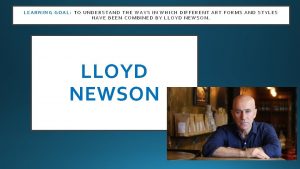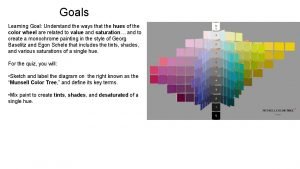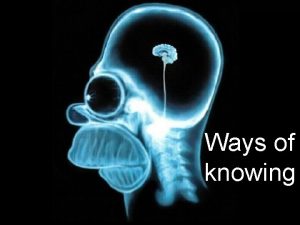LEARNING GOAL TO UNDERSTAND THE WAYS IN WHICH






- Slides: 6

LEARNING GOAL: TO UNDERSTAND THE WAYS IN WHICH DIFFERENT ART FORMS AND STYLES HAVE BEEN COMBINED BY KURT JOOSS

LEARNING GOAL: TO UNDERSTAND THE WAYS IN WHICH DIFFERENT ART FORMS AND STYLES HAVE BEEN COMBINED BY KURT JOOSS. B ACKGRO UND • Born 1901. German dancer, teacher and choreographer. • His dance dramas combined expressionistic modern-dance movements with fundamental ballet technique. • Jooss trained in dance from 1920 to 1924 with Rudolf Laban and then worked as choreographer for the avant-garde Neue Tanzbühne (“New Dance Stage”). • In 1932 he choreographed The Green Table, which won first prize in the choreographic competition organized by the International Archives of Dance in Paris. • Subsequently his group became known as Ballets Jooss and made a world tour during 1933 and 1934. • Because Adolf Hitler had come to power, Jooss did not return to Germany but with Sigurd Leeder made his headquarters at Dartington Hall, Devon, Eng. , where many students came to study his approach to dance.

LEARNING GOAL: TO UNDERSTAND THE WAYS IN WHICH DIFFERENT ART FORMS AND STYLES HAVE BEEN COMBINED BY KURT JOOSS’S STY LE • Jooss retained basic ballet steps and positions in his choreography and made extensive use of expressive gesture but eliminated such displays of virtuosity as the use of points and multiple pirouettes. • At his school at Dartington Hall and later at Essen, Jooss formalized his approach by further developing eukinetics, a system originated by Laban and designed to enable a dancer to perform a wide variety of dance styles with expression and control. • Through his eclectic choreography and his teaching, Jooss expanded the technical and thematic range of theatrical dance.

LEARNING GOAL: TO UNDERSTAND THE WAYS IN WHICH DIFFERENT ART FORMS AND STYLES HAVE BEEN COMBINED BY KURT JOOSS. REPERTOIRE- THE GREEN TABLE • Jooss’s masterpiece, The Green Table, is a caustic satire on the futility of war and peace negotiations of the 1930’s. His other ballets, which include The Big City (1932) and The Seven Heroes (1933), also have contemporary themes or implications. • The Green Table is a mature example of this technique. It uses elements of classical ballet, such as turn-out, demi-pointe, extensions, turns, arabesques, and other ballet steps. However, there is no pointe work or any other feature that could suggest virtuoso display.

LEARNING GOAL: TO UNDERSTAND THE WAYS IN WHICH DIFFERENT ART FORMS AND STYLES HAVE BEEN COMBINED BY KURT JOOSS. REPERTOIRE- THE GREEN TABLE • The gracefulness, elegance, ethereal quality, and other affectations of classical ballet are eliminated. • Rather than the relaxed wrists of ballet, Jooss uses stretched palms, fists, reaching hands, and so on. • The focus of the dancers also varies, shifting towards the centre of drama, rather than being primarily towards the audience, as in ballet. How do we see his style in the work? Identify the different art forms with examples.

LEARNING GOAL: TO UNDERSTAND THE WAYS IN WHICH DIFFERENT ART FORMS AND STYLES HAVE BEEN COMBINED BY KURT JOOSS. WO RKSHOP • First, second, third, fourth and fifth positions. • Arabesques. • Retires. • Releve. • Attitude. • Split into two groups and place yourselves around the table. • Create a short motif that uses balletic movement and gestures (politicians). • You must come away from the table at least once. • Remember. . . it is about combining modern dance, ballet and theatre.











